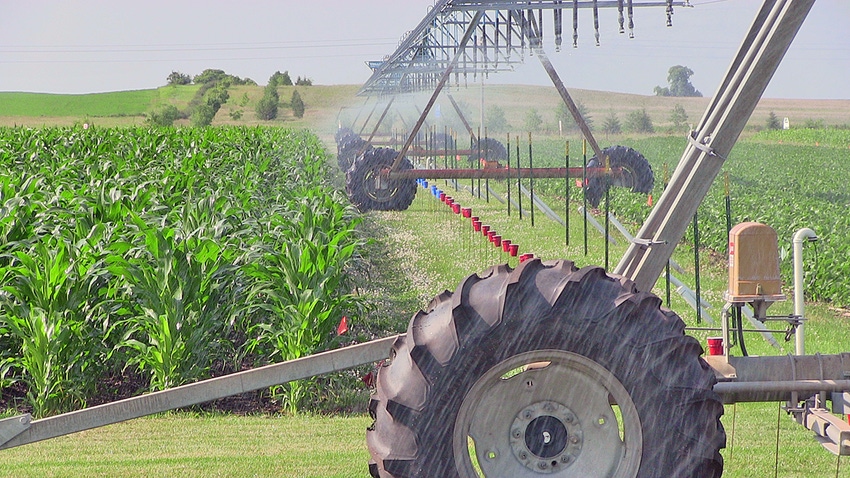May 6, 2016

A single bad nozzle near the end of your center pivot could cost you hundreds of dollars of lost revenue.
In a high-yielding, irrigated environment, one broken nozzle 1,000 feet from the center affects water delivery on nearly two acres, and “could cost you $600-1,000 in lost corn yield,” says Joshua Stamper, University of Minnesota Extension irrigation specialist.
Checking your irrigators every few years for application uniformity “is a low cost way to make sure that your water is going where you want it,” Stamper says. “It doesn’t take a lot of time, but it has the potential for a high return to management. Walk the length of your pivots each spring to inspect the condition of each nozzle. And keep in mind that “the farther away from the pivot point you go, the more money you stand to lose on a broken or poorly performing nozzle,” he says.
Distribution uniformity can be checked easily with a “catch can” test, says Katie Winkelman, soil conservationist for Stearns County, Minn., Soil and Water Conservation District. Water collection cups are placed along the length of the irrigator. After the pivot passes over all the catch cans, the water volume in each cup is measured. The data is entered into a spreadsheet that graphs the variations in water application depth along the pipe, so you can identify nozzles that are deviating from the pivot setting.
Free irrigation uniformity testing is available from many county SWCD offices. Or, you can rig up your own test. Go to the University of Minnesota’s Extension irrigation website for free instructions and spreadsheets.
Diagnosing uneven application
The most common cause of uneven water application is worn out, plugged or damaged nozzles, Stamper says. Non-uniform distribution can also be caused by pipeline leaks, improper pressure or incorrect nozzle size, spacing, height or end gun rotation. When drop nozzles are dragged through the crop canopy, that also causes uneven water distribution, Stamper adds, even if the pivot’s uniformity pattern is good.
Incorrectly sized nozzles caused uneven water application on two of Dave Lochen’s seven center pivots. On an older sprinkler, which he had converted from high to low pressure, the catch can test showed that several nozzles near the center were overwatering, “and we needed to put smaller nozzles there.”
The results prompted Lochen, who grows corn, soybeans and canning vegetables near Kimball, Minn., to check three more pivots, too.
Two were performing well, delivering uniformity coefficients over 90%, but the third had several incorrectly placed nozzles, the test revealed. The nozzles had been mixed up during installation, and “should have been at the end of the system,” Lochen says. “They were three to four times too large, so they were applying too much water.”
The misplaced nozzles were also delivering too much nitrogen fertilizer through the pivot, Lochen adds, wasting money and increasing the risk of loss to the environment.
Amid the press of more urgent work, it’s easy to skip regular uniformity checkups, Stamper says. “But this gets to the heart of precision agriculture: The right amount of water, at the right time, in the right place.”
When should you check irrigation uniformity?
Concentric rings on yield maps or aerial imagery should prompt you to check irrigation uniformity, says Jeff McManigle, president of West Central Irrigation, Starbuck, Minn.
You should also check uniformity if your sprinkler pressure is out of spec — often an indication of nozzle problems, McManigle says. It’s also a good idea to check uniformity any time you’ve made changes to your irrigation machinery, such as a new pump or end-gun replacement, he says.
Remember that nozzles wear out, says Joshua Stamper, University of Minnesota Extension irrigation specialist. So “if you cannot remember when you last installed or tested a nozzle package on your pivot, it’s probably time to conduct a uniformity test!
About the Author(s)
You May Also Like




